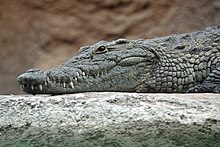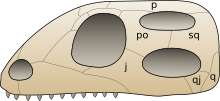Diapsid
| Diapsid reptiles Temporal range: Pennsylvanian–Present,
| |
|---|---|

| |
| Skull diagram of the araeoscelidian Petrolacosaurus kansensis | |

| |
| Nile crocodile (Crocodylus niloticus) | |
| Scientific classification | |
| Domain: | Eukaryota |
| Kingdom: | Animalia |
| Phylum: | Chordata |
| Class: | Reptilia |
| Clade: | Romeriida |
| Clade: | Diapsida Osborn, 1903 |
| Subgroups | |
| |
Diapsids ("two arches") are a clade of sauropsids, distinguished from more primitive eureptiles by the presence of two holes, known as temporal fenestrae, in each side of their skulls. The group first appeared about three hundred million years ago during the late Carboniferous period.[1] All diapsids other than the most primitive ones in the clade Araeoscelidia are often placed into the clade Neodiapsida. The diapsids are extremely diverse, and include birds and all modern reptile groups, including turtles, which were historically thought to lie outside the group.[2] All modern reptiles and birds are placed within the neodiapsid subclade Sauria. Although some diapsids have lost either one hole (lizards), or both holes (snakes and turtles), or have a heavily restructured skull (modern birds), they are still classified as diapsids based on their ancestry. At least 17,084 species of diapsid animals are extant: 9,159 birds,[3] and 7,925 snakes, lizards, tuatara, turtles, and crocodiles.[4]
Characteristics
[edit]
The name Diapsida means "two arches", and diapsids are traditionally classified based on their two ancestral skull openings (temporal fenestrae) posteriorly above and below the eye. This arrangement allows for the attachment of larger, stronger jaw muscles, and enables the jaw to open more widely. A more obscure ancestral characteristic is a relatively long lower arm bone (the radius) compared to the upper arm bone (humerus).
Basal-non saurian neodiaspids were ancestrally lizard-like, but basal non-saurian neodiapsids include aquatic/amphibious taxa (Claudiosaurus and some tangasaurids)[5] the gliding lizard-like Weigeltisauridae,[6] as well as the Triassic chameleon-like drepanosaurs.[7]
Classification
[edit]Diapsids were originally classified as one of four subclasses of the class Reptilia, all of which were based on the number and arrangement of openings in the skull. The other three subclasses were Synapsida (one opening low on the skull, for the "mammal-like reptiles"), Anapsida (no skull opening, including turtles and their relatives), and Euryapsida (one opening high on the skull, including many prehistoric marine reptiles). With the advent of phylogenetic nomenclature, this system of classification was heavily modified. Today, the synapsids are often not considered true reptiles, while Euryapsida were found to be an unnatural assemblage of diapsids that had lost one of their skull openings. Genetic studies and the discovery of the Triassic Pappochelys have shown that this is also the case in turtles, which are actually heavily modified diapsids. In phylogenetic systems, birds (descendants of traditional diapsid reptiles) are also considered to be members of this group.
Some modern studies of reptile relationships have preferred to use the name "diapsid" to refer to the crown group of all modern diapsid reptiles but not their extinct relatives. However, many researchers have also favored a more traditional definition that includes the prehistoric araeoscelidians. In 1991, Laurin defined Diapsida as a clade, "the most recent common ancestor of araeoscelidians, lepidosaurs, and archosaurs, and all its descendants".[8]
The clade Neodiapsida was given a phylogenetic definition by Laurin in 1991. He defined it as the branch-based clade containing all animals more closely related to "Younginiformes" (later, more specifically, emended to Youngina capensis) than to Petrolacosaurus (representing Araeoscelidia).[9]
A cladistic analysis by Laurin and Piñeiro (2017) recovers Parareptilia as part of Diapsida, with pareiasaurs, turtles, millerettids, and procolophonoids recovered as more derived than the basal diapsid Younginia.[10] A 2020 study by David P. Ford and Roger B. J. Benson also recovered Parareptilia as deeply nested within Diapsida as the sister group to Neodiapsida. However, this excludes mesosaurs, who were found to be basal among the sauropsids.[11]
All genetic studies have supported the hypothesis that turtles are diapsid reptiles; some have placed turtles within archosauromorpha,[12][13] or, more commonly, as a sister group to extant archosaurs.[14][15][16][17]
Simões et al. (2022) recovers araeoscelidians as stem-amniotes alongside captorhinids, placing many reptiles not traditionally considered diapsids, as well as synapsids (and therefore mammals), as diapsids under Diapsida's current node-based definition.[18] The position of the highly derived Mesozoic marine reptile groups Thalattosauria, Ichthyosauromorpha and Sauropterygia within Neodiapsida is uncertain, and they may lie within Sauria.[19]
Relationships
[edit]Below are cladograms showing the relations of the major groups of diapsids.
Cladogram after Bickelmann et al., 2009[20] and Reisz et al., 2011:[21]
The cladogram of Lee (2013) below used a combination of genetic (molecular) and fossil (morphological) data.[22]
| Diapsida |
| |||||||||||||||||||||||||||||||||||||||||||||||||||||||||
This second cladogram is based on the 2017 study by Pritchard and Nesbitt.[23]
| Neodiapsida | |
The following cladogram was found by Simões et al. (2022): [18]
| Neoreptilia |
| ||||||||||||||||||||||||||||||||||||||||||||||||||||||||||||
See also
[edit]References
[edit]- ^ "Diapsida". ucmp.berkeley.edu.
- ^ Schoch, Rainer R.; Sues, Hans-Dieter (2016). "The diapsid origin of turtles". Zoology. 119 (3): 159–161. Bibcode:2016Zool..119..159S. doi:10.1016/j.zool.2016.01.004. PMID 26934902.
- ^ Barrowclough, George F.; Cracraft, Joel; Klicka, John; and Zink, Robert M. (23 November 2016). Green, Andy J (ed.). "How Many Kinds of Birds Are There and Why Does It Matter?". PLOS ONE. 11 (11): e0166307. Bibcode:2016PLoSO..1166307B. doi:10.1371/journal.pone.0166307. PMC 5120813. PMID 27880775.
- ^ Reeder, Tod W.; Townsend, Ted M.; Mulcahy, Daniel G.; Noonan, Brice P.; Wood, Perry L. Jr.; Sites, Jack W. Jr.; and Wiens, John J. (2015). Wilf, Peter (ed.). "Integrated Analyses Resolve Conflicts over Squamate Reptile Phylogeny and Reveal Unexpected Placements for Fossil Taxa". PLOS ONE. 10 (3): e0118199. Bibcode:2015PLoSO..1018199R. doi:10.1371/journal.pone.0118199. PMC 4372529. PMID 25803280.
- ^ Nuñez Demarco, Pablo; Meneghel, Melitta; Laurin, Michel; Piñeiro, Graciela (2018-07-27). "Was Mesosaurus a Fully Aquatic Reptile?". Frontiers in Ecology and Evolution. 6: 109. doi:10.3389/fevo.2018.00109. hdl:20.500.12008/30631. ISSN 2296-701X.
- ^ Pritchard, Adam C.; Sues, Hans-Dieter; Scott, Diane; Reisz, Robert R. (2021-05-20). "Osteology, relationships and functional morphology of Weigeltisaurus jaekeli (Diapsida, Weigeltisauridae) based on a complete skeleton from the Upper Permian Kupferschiefer of Germany". PeerJ. 9: e11413. doi:10.7717/peerj.11413. ISSN 2167-8359. PMC 8141288. PMID 34055483.
- ^ Pritchard, Adam C.; Nesbitt, Sterling J. (October 2017). "A bird-like skull in a Triassic diapsid reptile increases heterogeneity of the morphological and phylogenetic radiation of Diapsida". Royal Society Open Science. 4 (10): 170499. Bibcode:2017RSOS....470499P. doi:10.1098/rsos.170499. ISSN 2054-5703. PMC 5666248. PMID 29134065.
- ^ Benton, M. J., Donoghue, P. C., Asher, R. J., Friedman, M., Near, T. J., & Vinther, J. (2015). "Constraints on the timescale of animal evolutionary history." Palaeontologia Electronica, 18.1.1FC; 1-106; palaeo-electronica.org/content/fc-1
- ^ Reisz, Robert R.; Modesto, Sean P.; Scott, Diane M. (22 December 2011). "A new Early Permian reptile and its significance in early diapsid evolution". Proceedings of the Royal Society B: Biological Sciences. 278 (1725): 3731–3737. doi:10.1098/rspb.2011.0439. PMC 3203498. PMID 21525061.
- ^ Laurin, Michel; Piñeiro, Graciela H. (2017). "A Reassessment of the Taxonomic Position of Mesosaurs, and a Surprising Phylogeny of Early Amniotes" (PDF). Frontiers in Earth Science. 5: 88. Bibcode:2017FrEaS...5...88L. doi:10.3389/feart.2017.00088. S2CID 32426159.
- ^ Ford DP, Benson RB (January 2020). "The phylogeny of early amniotes and the affinities of Parareptilia and Varanopidae". Nature Ecology & Evolution. 4 (1): 57–65. doi:10.1038/s41559-019-1047-3. PMID 31900445. S2CID 209673326.
- ^ Lee, M. S. Y. (2013). "Turtle origins: Insights from phylogenetic retrofitting and molecular scaffolds". Journal of Evolutionary Biology. 26 (12): 2729–2738. doi:10.1111/jeb.12268. PMID 24256520. S2CID 2106400.
- ^ Mannen, Hideyuki; Li, Steven S. -L. (Oct 1999). "Molecular evidence for a clade of turtles". Molecular Phylogenetics and Evolution. 13 (1): 144–148. doi:10.1006/mpev.1999.0640. PMID 10508547.
- ^ Zardoya, R.; Meyer, A. (1998). "Complete mitochondrial genome suggests diapsid affinities of turtles". Proc Natl Acad Sci U S A. 95 (24): 14226–14231. Bibcode:1998PNAS...9514226Z. doi:10.1073/pnas.95.24.14226. ISSN 0027-8424. PMC 24355. PMID 9826682.
- ^ Iwabe, N.; Hara, Y.; Kumazawa, Y.; Shibamoto, K.; Saito, Y.; Miyata, T.; Katoh, K. (2004-12-29). "Sister group relationship of turtles to the bird-crocodilian clade revealed by nuclear DNA-coded proteins". Molecular Biology and Evolution. 22 (4): 810–813. doi:10.1093/molbev/msi075. PMID 15625185.
- ^ Roos, Jonas; Aggarwal, Ramesh K.; Janke, Axel (Nov 2007). "Extended mitogenomic phylogenetic analyses yield new insight into crocodylian evolution and their survival of the Cretaceous–Tertiary boundary". Molecular Phylogenetics and Evolution. 45 (2): 663–673. doi:10.1016/j.ympev.2007.06.018. PMID 17719245.
- ^ Katsu, Y.; Braun, E. L.; Guillette, L. J. Jr.; Iguchi, T. (2010-03-17). "From reptilian phylogenomics to reptilian genomes: analyses of c-Jun and DJ-1 proto-oncogenes". Cytogenetic and Genome Research. 127 (2–4): 79–93. doi:10.1159/000297715. PMID 20234127. S2CID 12116018.
- ^ a b Simões, Tiago R.; Kammerer, Christian F.; Caldwell, Michael W.; and Pierce, Stephanie E. (2022). "Successive climate crises in the deep past drove the early evolution and radiation of reptiles". Science Advances. 8 (33): eabq1898. Bibcode:2022SciA....8.1898S. doi:10.1126/sciadv.abq1898. PMC 9390993. PMID 35984885.
- ^ Simões, Tiago R.; Kammerer, Christian F.; Caldwell, Michael W.; Pierce, Stephanie E. (2022-08-19). "Successive climate crises in the deep past drove the early evolution and radiation of reptiles". Science Advances. 8 (33): eabq1898. Bibcode:2022SciA....8.1898S. doi:10.1126/sciadv.abq1898. ISSN 2375-2548. PMC 9390993. PMID 35984885.
- ^ Bickelmann, Constanze; Müller, Johannes; and Reisz, Robert R. (2009). "The enigmatic diapsid Acerosodontosaurus piveteaui (Reptilia: Neodiapsida) from the Upper Permian of Madagascar and the paraphyly of younginiform reptiles". Canadian Journal of Earth Sciences. 49 (9): 651–661. Bibcode:2009CaJES..46..651S. doi:10.1139/E09-038.
- ^ Reisz, Robert R.; Modesto, Sean P.; and Scott, Diane M. (2011). "A new Early Permian reptile and its significance in early diapsid evolution". Proceedings of the Royal Society B. 278 (1725): 3731–7. doi:10.1098/rspb.2011.0439. PMC 3203498. PMID 21525061.
- ^ Lee, M. S. Y. (2013). "Turtle origins: Insights from phylogenetic retrofitting and molecular scaffolds". Journal of Evolutionary Biology. 26 (12): 2729–2738. doi:10.1111/jeb.12268. PMID 24256520. S2CID 2106400.
- ^ Pritchard, Adam C.; Nesbitt, Sterling J. (2017-10-11). "A bird-like skull in a Triassic diapsid reptile increases heterogeneity of the morphological and phylogenetic radiation of Diapsida". Royal Society Open Science. 4 (10): 170499. Bibcode:2017RSOS....470499P. doi:10.1098/rsos.170499. ISSN 2054-5703. PMC 5666248. PMID 29134065.








